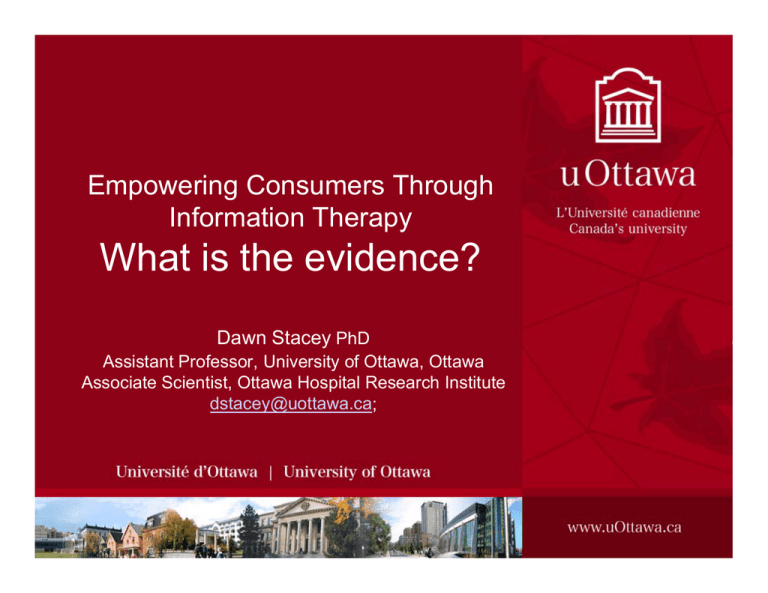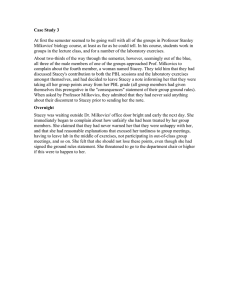What is the evidence? Empowering Consumers Through Information Therapy Dawn Stacey
advertisement

Empowering Consumers Through Information Therapy What is the evidence? Dawn Stacey PhD Assistant Professor, University of Ottawa, Ottawa Associate Scientist, Ottawa Hospital Research Institute dstacey@uottawa.ca; Key Messages - Patient decision aids: - Consistently improve knowledge and prepare patients for discussing decisions - Reduce elective surgery by 24% (prostate, spine, uterus) – Involved patients have better outcomes – Implementation requires • Training for patients/professionals • Integration in routine care Stacey 2010 Outline • What is a patient decision aid? • Do patient decision aids work? • How do we get them used? Stacey 2010 Patient Decision Aids adjuncts to counseling Inform: • facts • probabilities Clarify values • experience • ask Support • guide • summary worksheets Stacey 2010 International Patient Decision Aid Standards (IPDAS) Collaboration Home What are Patient Decision Aids? Who’s Involved? Contact Us Elwyn et al., (2006) in BMJ 333(7565):417 Ewyn et al. (2009) in PLoS ONE, 4(3), 1-9 Objective: Establish internationally approved criteria to determine the quality of patient decision aids. These criteria are helpful to individuals and organizations that use and/or develop patient decision aids: – Patients – Practitioners >100 participants – Developers from 14 countries – Researchers – Policy makers or payers To learn more, visit: www.ohri.ca/decisionaid Stacey 2010 Summary Report for Surgeons Stacey 2010 Stacey, D. et al. BMJ 2008;0:bmj.39520.701748.94v2-bmj.39520.701748.94 Compared to standard care, patient decision aids … 15% knowledge scores 70% accurate risk perception 50% undecided 40% passive in decision making ~ Decisions -24% surgery; -20% PSA; -29% HRT no effect on other decisions No/minimal effect on anxiety, satisfaction, health outcomes ? Costs, communication, adherence, degree of detail required O’Connor et al., Cochrane Library, 2009 Stacey 2010 Decision Aids reduce rates of discretionary surgery by 24% 0% 25% 50% 75% CA-Prostatectomy CAOrchiectomy* back surgery mastectomy RR=0.76 (0.6, 0.9) mastectomy* . hysterectomy hysterectomy* bphprostatectomy Standard Care D-Aid bphprostatectomy coronary bypass* coronary bypass Stacey 2010 (O’Connor, Bennett, Stacey et al., Cochrane Library, 2009) Decision aids are not enough: change in decisional needs of women considering breast ca surgery (n=125) Uninformed Unclear Values Unsupported Stacey 2010 (Collins ED et al. 2009 in J Clinical Oncology) Uncertain Total DCS Coaching may $0 be needed $500 $1,000 (hysterectomy) Standard care, $2,751 Decision Aid Alone, $2,026 (Kennedy et al. JAMA 2002; 288: 2701-2708) Stacey 2010 Decision Aid PLUS Coaching, $1,566 $1,500 $2,000 $2,500 25 Reviews: 22 Reviews: Health Literacy Interventions Clinical Decision Making Interventions 0 5 10 15 20 0 5 10 15 67 Reviews: Self Care & Chronic Disease Self Management interventions 20 0 20 40 60 Knowledge Positive Mixed No Effect Experience UseHealthService Behaviour and Health Status Stacey 2010 Patients involved in decision making • Improve – quality of life – sense of control over illness – symptom relief • Decrease – fatigue – depression – illness concerns However, most patients would prefer more active involvement Stacey 2010 (Kiesler & Auerbach 2006, Pt Ed Counsel, 61:319-341) To improve adoption of shared decision making by healthcare professionals… Need to use multiple interventions (4/5 trials): • Educational materials (e.g. patient decision aids, coaching protocols) • Training for health professionals • Audit and feedback • More research needed on costs and necessary resources F Légaré, S Ratté, D Stacey, J Kryworuchko, K Gravel, ID Graham, S Turcotte, PO D’Amours, January 2010 preliminary results GOOGLE: ‘decision aid’ Stacey 2010 Stacey 2010 Stacey 2010 Key Messages - Patient decision aids: - Consistently improve knowledge and prepare patients for discussing decisions - Reduce elective surgery by 24% (prostate, spine, uterus) – Involved patients have better outcomes – Implementation requires • Training for patients/professionals • Integration in routine care Stacey 2010 Stacey 2010 www.ohri.ca/decisionaid Empowering Consumers Through Information Therapy What is the evidence? Dawn Stacey PhD Assistant Professor, University of Ottawa, Ottawa Associate Scientist, Ottawa Hospital Research Institute dstacey@uottawa.ca;


